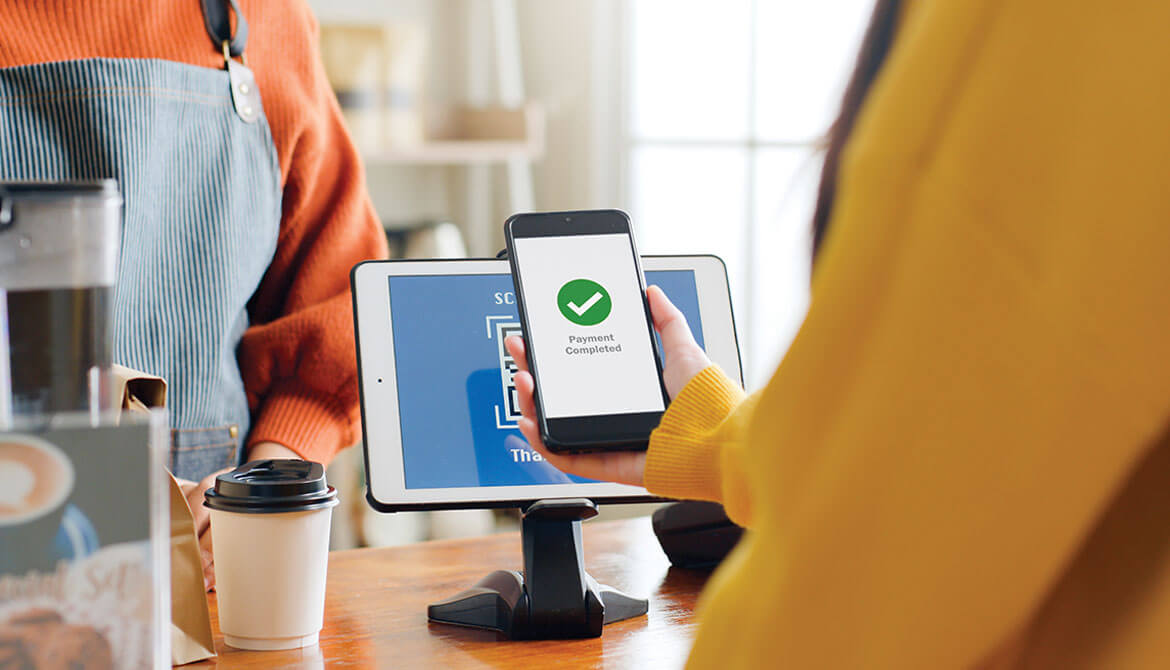8 minutes
Experts share the hot payment trends that are currently surging in the market.
Though the financial sector will see many trends come and go, people and businesses of all sizes will always have to pay their bills. And though that will never change, the way we make payments certainly has. From a surge in buy now, pay later to real-time payments and digital wallets, how we make purchases, big and small alike, has evolved greatly in recent years. That’s why we tapped two experts in the credit union industry to share the biggest payment trends they are seeing in the market right now—and how that effects our money.
Payment Plan
One way or another, the buy now, pay later model has practically always existed—it’s just the marketing and language around it that has changed. Essentially, yesterday’s layaway plan is today’s Klarna.
“A lot of people in the marketplace are talking about it in different ways,” says Brian Scott, chief growth officer of CUESolutions provider PSCU, noting that even Apple recently announced they’re jumping on the BNPL bandwagon. “The question is: Do they have a business model? I think it’s super interesting to look at all the reasons why somebody’s in that space. Apple’s in there, in essence, to sell more stuff and to make it easier for consumers to buy more stuff from them.”
But it’s not just the businesses that benefit. “I think from a consumer perspective, and from a credit union perspective too, you can use buy now, pay later as a way to budget and better improve your financial situation, not necessarily just to buy things,” Scott says. “Buy now, pay later is a different way to budget, maybe not putting something on a credit card and paying it off over 36 months, but paying it off over six or 12 weeks.”
Scott explains that if you suddenly must buy a new refrigerator or washer and dryer, for example, point-of-sale financing has been around for a long time, but you may not necessarily want to open a line of credit or put that on your credit card. By using buy now, pay later, you’re not taking out more credit or a credit line—you’re just paying it off in a different way. “I think it’s important to make those distinctions for financial institutions, banks and credit unions,” he says.
This business model doesn’t just affect your individual financial situation because it has a broader influence. “It may impact the number of people that take different kinds of loans,” Scott says. “Make no mistake, it’s still a loan. But you’re ultimately helping your members improve their financial journey through life. And I think if you’re doing that, that builds trust, so there’s a very positive outcome and positive reason why credit unions should be offering buy now, pay later.”
Another major payment trend shaking things up is real-time payments. For example, if a handyman comes to your home and does some painting and repair work, you no longer have to wait to receive an invoice and then send them a check in the mail. Thanks to payments apps and other real-time payment options, they can be paid instantly on the spot.
“There are a lot of benefits to be able to reduce transaction errors and fraud and help small businesses,” Scott says. “Small businesses are a great use case that a lot of financial institutions—credit unions in particular—that are trying to go after that marketplace miss. If you can enable real-time payments, faster payments for your small businesses, it means your small business can receive payments from their customers in seconds instead of days, weeks or months. It makes a big difference for a small business. It’s a huge benefit for financial institutions to implement real-time payments.”
A third trend in the payments realm is digital issuance. These days, you simply can’t get a new credit card into the hands—and digital wallets—of members fast enough. “It is remarkable to me how consumers are demanding things immediately,” Scott says. “If you go to a credit union, you get a new account or you apply for a credit card, you can have that credit card in your wallet through digital issuance … the second you leave.”
This has become table stakes for consumers, and Scott warns that banks and CUs that aren’t offering that yet are falling behind. “People expect it; it’s a huge thing,” he says. “Today, what we see is only about a quarter of CUs are even offering digital issuance.” According to digital issuance research, the percentage of members who almost immediately use that card, even the same day, is very high.
“Everybody’s fighting for top of wallet, and there’s nothing better to get top of wallet than digital issuance,” Scott says. “It’s one of those areas that we really are pushing on. I wish it was a bigger trend than it is. It’s certainly a trend with consumers. We just don’t see it as much with credit unions.”
Doing Digital Differently
The payments space was forever changed once the iPhone was introduced. “We can thank Steve Jobs for the moment he walked out on stage and showed the first iPhone to the world; it has affected everything downstream from there,” says Anthony Mondello, AVP/sales at CUES Supplier member Envisant.
The trickle-down effects are still being felt today, which is why Mondello believes the most important trend in the payments space right now is meeting members at their phone. If credit unions aren’t doing that, he warns, they’re making a mistake.
“I think digital wallet adoption on payments is huge,” Mondello says. “It needs to be something that’s table stakes now for credit unions.” He cites that Gen Z has nearly fully adapted to a digital wallet, and even Gen X is over 50%, according to the ACI Worldwide 2022 Annual Pulse Report. “Mobile wallets are replacing web wallets, and I think the tipping point is here for digital wallets,” he adds.
At the same time, surprisingly, debit cards are actually gaining in popularly. “I think it’s a generational thing,” Mondello says. “I’m comfortable with using my credit card and getting points and paying it off every month, but it took years of discipline getting to that point. Somebody who’s just coming up, they don’t want credit card debt—they’re told it’s bad, and they use debit, so we’re seeing a lot more debit usage these days.” He’s seen a 3% increase in debit card usage year over year, highlighting how important it is for credit unions to meet consumers there and offer more in the debit card space.
Additionally, Mondello believes that buy now, pay later options will continue to evolve and shift the payment space. As credit unions and the financial world at large are still working to navigate the buy now, pay later space, Mondello thinks BNPL will have a larger effect that no one can precisely predict right now. “The usage on buy now, pay later has increased,” he says. “In the short- and medium-term, I think it’s going to stay there. But I really do feel that with everything else going on in the world right now with credit losses, there’s going to be a change there, but we just don’t know yet what it is. The sector is probably going to lose its unregulated status at some point, and then this rapid expansion will probably slow down because it will be regulated. I view it as a short-term gain that may be a long-term game-changer in payments.”
Yet another trend in the payments space is new competitors giving traditional banks and credit unions a literal run for their money. Mondello points to Venmo now being accepted by Amazon. “That’s also a competitive concern for most traditional banking folks,” he says. “I think that could be something that is also a pretty big trend.”
Eventually, Mondello wonders whether Gen Z will even need a wallet one day. “I firmly believe there’s no way the next generation is going to be carrying cards around,” he says. “The question is just when does that happen? And what downstream effect does it have? Who knows, because Apple Pay will be still be there. That’s why, as an issuer, you have to make sure your card is in the phone wallet. That’s the one thing I will tell all of our credit unions all the time. We need to … add those to your program and modernize your program.”
If a credit or debit card isn’t capable of going into a digital wallet, Mondello warns that consumers will go for the next card that does instead.
“Wallet adoption now has become the biggest thing,” he says. Mondello notes that the payments industry has changed so incrementally over the last few years that people don’t even realize how much things have shifted, citing that something as simple and ubiquitous as receiving paper statements in the mail is on the verge of becoming obsolete.
“There’s a big change that’s happened over the last few years that we’ve just not really noticed,” Mondello says. “All of a sudden, everything’s digital. So, you probably have an app on your phone, and you can pay right on your phone, or you go to your online bank and you pay that way. … The payments ecosystem [has] changed without us really even paying much mind to it.” And credit unions need to keep pace with all of that digital change to stay fresh and relevant. cues icon
Celia Shatzman has penned stories on topics ranging from beauty to fashion, finance, travel, celebrities, health and entertainment.






